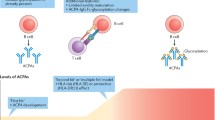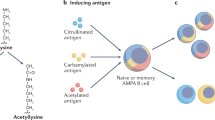Abstract
The recent demonstration of efficacy in the treatment of rheumatoid arthritis with B-cell-depleting therapy, along with the increasing understanding of the role of anticitrullinated protein antibodies (ACPA) have begun to provide new insights into the pathogenesis of this complex disease. This manuscript reviews the current understanding of ACPA with regard to clinical associations and pathogenic mechanisms in preclinical animal models. These data are synthesized into a model of the development of rheumatoid arthritis that refocuses attention on the role of B cells and immune complexes, returning in part to the origins of scientific investigation in this disease, and points to directions of research that are necessary to achieve the full therapeutic, diagnostic, and prognostic potential of the ACPA antigen-antibody system.
Similar content being viewed by others
References and Recommended Reading
Arend WP: The innate immune system in rheumatoid arthritis. Arth Rheum 2001, 44:2224–2234.
Toh ML, Miossec P: The role of T cells in rheumatoid arthritis: new subsets and new targets. Cur Opin Rheum 2007, 19:284–288.
Weyand CM: New insights into the pathogenesis of rheumatoid arthritis. Rheumatology 2000, 39(Suppl 1):3–8.
Zhang Z, Bridges SL: Pathogenesis of rheumatoid arthritis. Role of B lymphocytes. Rheum Dis Clin North Am 2001, 27:335–353.
Edwards JC, Szczepanski L, Szechinski J, et al.: Efficacy of B-cell-targeted therapy with rituximab in patients with rheumatoid arthritis. N Eng J Med 2004, 350:2572–2581.
Edwards JC, Cambridge G, Leandro MJ: B cell depletion therapy in rheumatic disease. Best Pract Res Clin Rheum 2006, 20:915–928.
Monach PA, Benoist C, Mathis D: The role of antibodies in mouse models of rheumatoid arthritis, and relevance to human disease. Adv Immunol 2004, 82:217–248.
Schrohenloher RE, Bridget SL, Koopman WJ: Rheumatoid factor. In: Arthritis and Allied Conditions: A Textbook of Rheumatology, edn 13. Edited by Koopman WJ. Baltimore, MD: Williams and Wilkins; 1997:1109–1130.
Schellekens GA, de Jong BA, van den Hoogen FH, et al.: Citrulline is an essential constituent of antigenic determinants recognized by rheumatoid arthritis-specific autoantibodies. J Clin Invest 1998, 101:273–281.
Masson-Bessiere C, Sebbag M, Girbal-Neuhauser E, et al.: The major synovial targets of the rheumatoid arthritis-specific antifilaggrin autoantibodies are deiminated forms of the a-and b-chains of fibrin. J Immunol 2001, 166:4177–4184.
van Venrooij WJ, Pruijn GJ: Citrullination: a small change for a protein with great consequences for rheumatoid arthritis. Arthritis Res 2000, 2:249–251.
Girbal-Neuhauser E, Durieux JJ, Arnaud M, et al.: The epitopes targeted by the rheumatoid arthritis-associated antifilaggrin autoantibodies are posttranslationally generated on various sites of (pro)filaggrin by deimination of arginine residues. J Immunol 1999, 162:585–594.
Goldbach-Mansky R, Lee J, McCoy A, et al.: Rheumatoid arthritis associated autoantibodies in patients with synovitis of recent onset. Arth Res Ther 2000, 2:236–243.
Lee DM, Schur PH: Clinical utility of the anti-CCP assay in patients with rheumatic diseases. Ann Rheum Dis 2003, 62:870–874.
Schellekens GA, Visser H, de Jong BA, et al.: The diagnostic properties of rheumatoid arthritis antibodies recognizing a cyclic citrullinated peptide. Arthritis Rheum 2000, 43:155–163.
Sauerland U, Becker H, Seidel M, et al.: Clinical utility of the anti-CCP assay: experiences with 700 patients. Ann N Y Acad Sci 2005, 1050:314–318.
Coenen D, Verschueren P, Westhovens R, Bossuyt X: Technical and diagnostic performance of 6 assays for the measurement of citrullinated protein/peptide antibodies in the diagnosis of rheumatoid arthritis. Clin Chem 2007, 53:498–504.
Machold KP, Stamm TA, Nell VP, et al.: Very recent onset rheumatoid arthritis: clinical and serological patient characteristics associated with radiographic progression over the first years of disease. Rheumatology (Oxford) 2007, 46:342–349.
Irigoyen P, Lee AT, Wener MH, et al.: Regulation of anti-cyclic citrullinated peptide antibodies in rheumatoid arthritis: contrasting effects of HLA-DR3 and the shared epitope alleles. Arthritis Rheum 2005, 52:3813–3818.
Russell AS, Devani A, Maksymowych WP: The role of anti-cyclic citrullinated peptide antibodies in predicting progression of palindromic rheumatism to rheumatoid arthritis. J Rheum 2006, 33:1240–1242.
Raza K, Breese M, Nightingale P, et al.: Predictive value of antibodies to cyclic citrullinated peptide in patients with very early inflammatory arthritis. J Rheum 2005, 32:203–207.
Klareskog L, Stolt P, Lundberg K, et al.: A new model for an etiology of rheumatoid arthritis: smoking may trigger HLA-DR (shared epitope)-restricted immune reactions to autoantigens modified by citrullination. Arthritis Rheum 2006, 54:38–46.
Rantapaa Dahlqvist S, de Jong BA, Hallmans G, et al.: Antibodies against cyclic citrullinated peptide and IgA rheumatoid factor predict the development of rheumatoid arthritis. Arthritis Rheum 2003, 48:2741–2749.
Berglin E, Padyukov L, Sundin U, et al.: A combination of autoantibodies to cyclic citrullinated peptide (CCP) and HLA-DRB1 locus antigens is strongly associated with the future onset of rheumatoid arthritis. Arth Res Ther 2004, 6:R303–R308.
Nielen MM, van Schaardenburg D, Reesink HW, et al.: Specific autoantibodies precede the symptoms of rheumatoid arthritis: study of serial measurements in blood donors. Arthritis Rheum 2004, 50:380–386.
Padyukov L, Silva C, Stolt P, et al.: A gene-environment interaction between smoking and shared epitope genes in HLA-DR provides a high risk of seropositive rheumatoid arthritis. Arthritis Rheum 2004, 50:3085–3092.
Rademacher TW, Williams P, Dwek RA: Agalactosyl glycoforms of IgG autoantibodies are pathogenic. Proc Natl Acad Sci U S A 1994, 91:6123–6127.
Kaneko Y, Nimmerjahn F, Ravetch JV: Anti-inflammatory activity of immunoglobulin G resulting from Fc sialylation. Science 2006, 313:670–673.
Wipke BT, Wang Z, Nagengast W, et al.: Staging the initiation of autoantibody-induced arthritis: a critical role for immune complexes. J Immunol 2004, 172:7694–7702.
Kuhn KA, Kulik L, Tomooka B, et al.: Antibodies to citrullinated proteins enhance tissue injury in experimental arthritis. J Clin Invest 2006, 116:961–973.
Hill JA, Southwood S, Sette A, et al.: The conversion of arginine to citrulline allows for a high-affinity peptide interaction with the rheumatoid arthritis-associated HLA-BRB1 * 0401 MHC Class II molecule. J Immunol 2003, 171:538–541.
Ireland J, Herzog J, Unanue ER: Cutting edge: unique T cells that recognize citrullinated peptides are a feature of protein immunization. J Immunol 2006, 177:1421–1425.
Rose NR, Bona C: Defining criteria for autoimmune diseases (Witebsky’s postulates revisited). Immunol Today 1993, 14:426–430.
Author information
Authors and Affiliations
Corresponding author
Rights and permissions
About this article
Cite this article
Holers, V.M. Antibodies to citrullinated proteins: Pathogenic and diagnostic significance. Curr Rheumatol Rep 9, 396–400 (2007). https://doi.org/10.1007/s11926-007-0063-5
Published:
Issue Date:
DOI: https://doi.org/10.1007/s11926-007-0063-5




